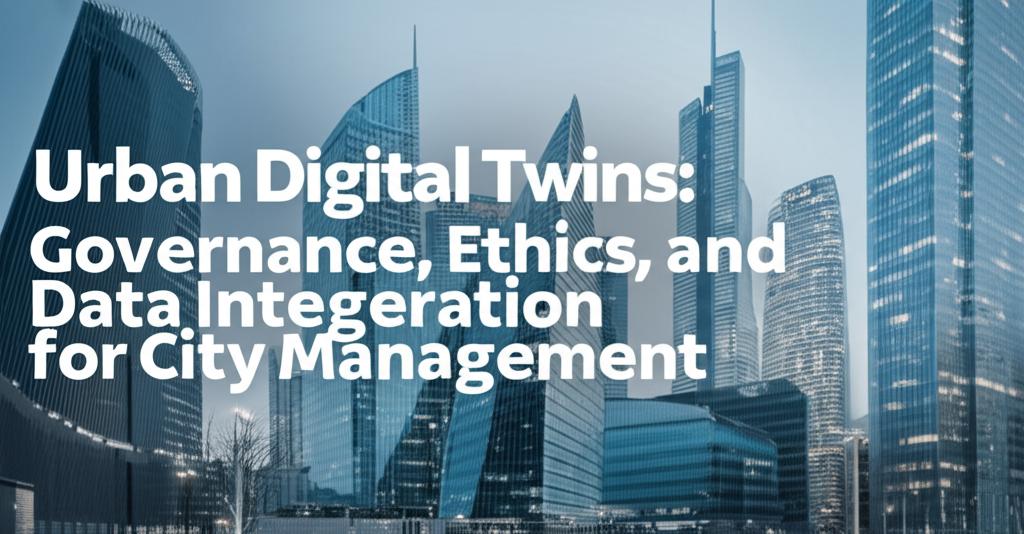Urban Digital Twins (UDTs) are transforming how cities are managed by creating dynamic virtual replicas of urban environments. These digital models integrate real-time data from various sources, including Internet of Things (IoT) sensors and 3D models, to simulate and analyze urban processes. This allows city planners and managers to make more informed decisions, optimize resource allocation, and improve the quality of life for citizens. However, the development and deployment of UDTs also bring significant governance, ethical, and data integration challenges that need careful consideration.
Governance FrameworksEffective governance is crucial for realizing the full potential of UDTs and ensuring their responsible use. Currently, governance frameworks for UDTs are still in their early stages of development. Key aspects of governance include:
- Transparency and Accountability: Establishing clear protocols for data collection, usage, and decision-making processes involving UDTs is essential. This includes ensuring that algorithms used in UDTs are transparent and unbiased.
- Public Participation: Involving citizens in the development and use of UDTs can foster trust and ensure that these technologies align with public values and priorities. Digital platforms can facilitate two-way communication and collaborative problem-solving between city officials and residents. Cities like Helsinki are using digital twins to allow residents to visualize and provide input on urban development projects.
- Adaptive Governance: Governance structures need to be flexible and adaptable to keep pace with the rapid evolution of UDT technology and changing urban needs. This includes developing policies that address data protection, privacy, and security.
- Maturity Models: Frameworks like the CITYSTEPS Maturity Model are being developed to assess the current state of city-scale digital twins (CDTs), predict their future development, and understand their governance implications. This helps in promoting more inclusive technology adoption.
The extensive data collection and analysis inherent in UDTs raise significant ethical questions that must be addressed:
- Data Privacy and Security: UDTs rely on vast amounts of data, some of which may be sensitive personal information. Stringent data protection measures are necessary to prevent unauthorized access, data breaches, and misuse of information for surveillance.
- Algorithmic Bias: The AI models and algorithms that power UDTs can reflect and amplify existing societal biases, potentially leading to inequitable outcomes in areas like resource distribution or law enforcement. It is crucial to develop ethical AI algorithms that prevent discrimination.
- Equity and Inclusion: There's a risk that UDTs could exclude marginalized groups, especially those often overlooked in data collection, such as the homeless or workers in the informal sector. A human-centric approach is needed to ensure UDTs benefit all members of society.
- Human Oversight: While UDTs can automate and optimize many urban processes, it's important to maintain human oversight in decision-making to prevent an erosion of accountability and to handle complex situations that require human judgment.
Integrating diverse and voluminous data sources is a cornerstone of UDT functionality, but it also presents considerable challenges:
- Heterogeneous Data Sources: UDTs need to integrate data from a multitude of sources, including sensors, existing city databases, 3D models, and real-time feeds. These data often come in different formats and from disparate systems, making integration complex.
- Interoperability: Ensuring that different systems and data formats can work together seamlessly is a major hurdle. Efforts like the OGC Urban Digital Twins Interoperability Pilot aim to improve the interoperability of geospatial data and analyses within UDTs.
- Data Quality and Management: Maintaining the accuracy, consistency, and timeliness of the data fed into UDTs is critical for their reliability. This requires robust data management practices and continuous updates.
- System Complexity: Integrating numerous systems to build a comprehensive UDT can lead to exponential increases in system complexity, making implementation and maintenance challenging.
- Lifecycle Data Integration: Data integration needs to be considered throughout the entire lifecycle of a UDT, from its creation and use to its updating phases. This involves extending data models, transforming data to meet model requirements, and integrating data at the front-end level.
Artificial Intelligence (AI) plays a pivotal role in enhancing the capabilities of UDTs. AI-powered digital twins can analyze vast amounts of data, improve real-time decision-making, and optimize city management. Generative AI is being used to design information management solutions and citizen engagement strategies, as well as in urban planning and governance by enabling anticipatory forms of governance. Technologies like large language models and geospatial foundation models are offering new ways for geospatial analysis and decision support.
Future Directions and Ongoing ResearchThe field of UDTs is rapidly evolving. Future research is expected to focus on:
- Refining solutions for data integration and interoperability.
- Developing more comprehensive ethical frameworks that address equity, autonomy, and fair access.
- Enhancing citizen engagement and participatory governance models.
- Exploring the integration of social dimensions into UDTs to create "Social Digital Twins" that better represent the interplay between physical and social systems.
- Establishing universal standards and comparative studies between traditional urban management methods and UDT approaches.
Cities like Singapore, Dubai, and Neom are pioneering the use of UDTs, providing valuable lessons and insights into the challenges and benefits of these technologies. As UDTs become more sophisticated and widely adopted, collaborative efforts between industry, policymakers, academics, and the public will be essential to harness their transformative potential for creating more sustainable, resilient, efficient, and inclusive urban environments.

